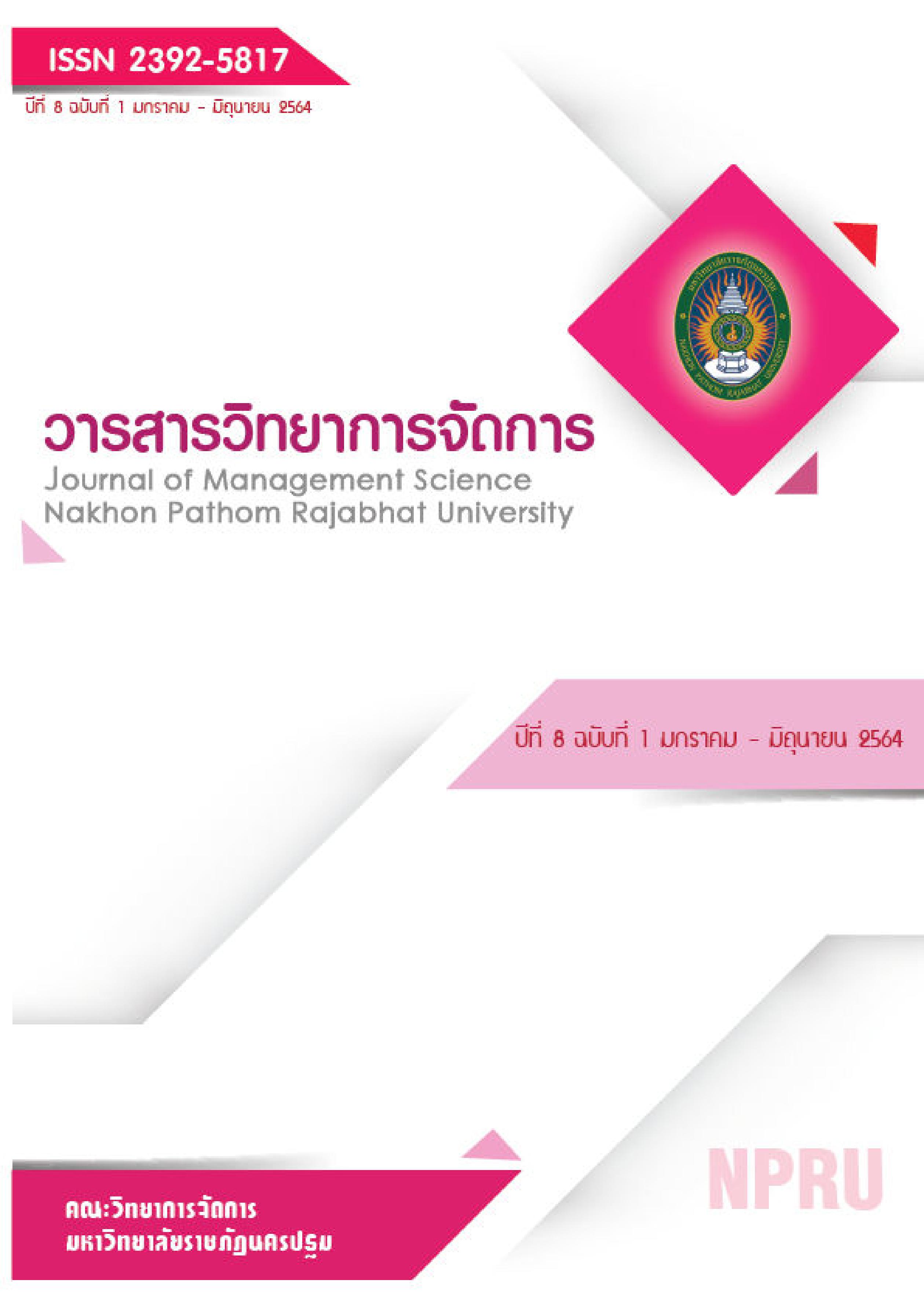A Quality Management Swiftlet’s Nest Business in Thailand
Main Article Content
Abstract
The objective of this research is to study the quality management of a bird-nest business operator in Thailand. Using qualitative research by interviewing 35 people. The main data were divided into three group. First, The swiftlet’s builder entrepreneurs. Second, The entrepreneurs of bird nest cleaning. Third, The entrepreneurs of bird nest distribution. By using PDCA quality management 1. Planning (P) 2. Do (D) 3. Check(C) 4. Action (A).
The research found that, to build a house in order to feed the birds and to renovate the house that used to feeds the bird, quality and color of the bird's nest is the most important. Operator need to take a serious attention to control the cleanliness in the house. Dash will cause disease, insect. Moreover, the biogas will cause acidity and alkalinity that affect to the colour, shape and thickness of the bird’s nest. Also, the operator has to pay attention to the temperature and humidity of the house, the temperature not to over 30 degrees and the relative humidity around 85-90% for the quality of the bird’s nest. In order to trick the swiftlet to come into the house the volume should be control not to over 80 decibels and open from 16.00-19.00 pm. is the time that the birds will be bent back to the house along to the living route. Food preservation must use in order to maintain the natural protein by bring PDCA to manage the quality because of the bird’s nest will stay in the house for 3-4 months and the bird’s nest contains protein >50%. Also, the result found that the entrepreneurs of the swiftlet can be also a bird’s nest washing operator for sale and able to control the bird’s nest business system of the whole process of PDCA
Article history: Received 4 April 2020
Revised 10 July 2020
Accepted 15 July 2020
SIMILARITY INDEX = 0.00 %
Article Details
The views and opinions of the article appearing in this journal are those of the author. It is not considered a view and responsibility of the editorial staff.
References
กรุงเทพธุรกิจ. (2559). รังนกแอ่น: เหมืองทองกลุ่มชาติพันธุ์เอเชียอาคเนย์ (1). [ออนไลน์]. ค้นเมื่อ 25 กรกฎาคม 2559 จาก https://www.bangkokbiznews.com/blog/detail/637089.
กิติสัณฑ์ กิจค้า. (สัมภาษณ์, 18 มิถุนายน 2560). ผู้ประกอบการ และประธานลานประมูลจังหวัดกระบี่.
เกษม จันทร์ดำ. (2550). รังนกแอ่น: อำนาจ ความขัดแย้ง และความมั่งคั่ง. กรุงเทพมหานคร: สำนักพิมพ์มหาวิทยาลัยมหาสารคาม.
โกศล ดีศีลธรรม. (2547). TOTAL QUALITY MANAGEMENT สู่องค์กรแห่งความเป็นเลิศด้วย TQM. (พิมพ์ครั้งที่ 22). กรุงเทพมหานคร: สำนักพิมพ์จุฬาลงกรณ์มหาวิทยาลัย.
กัญจน์ ปุญญทลังค์. (สัมภาษณ์, 18 มิถุนายน 2560). ผู้ประกอบการ จังหวัดชุมพร ประสบการณ์ 14 ปี.
เบญจวรรณ วานมนตรี (2016). การตรวจสอบการเปลี่ยนแปลงภายในไข่เยี่ยวม้าภายใต้สภาวะไฮโดรสแตติก.วิทยานิพนธ์วิศวกรรมเกษตรมหาบัณฑิต มหาวิทยาลัยเทคโนโลยีสุรนารีมหาวิทยาลัยเทคโนโลยีสุรนารี.
ปจิตรา สมหมาย.(2551). ธุรกิจบ้านรังนกอีแอ่นขุมทรัพย์สร้างได้ด้วยเทคโนโลยี. กรุงเทพธุรกิจ.22 (7325), 8-10.
ปริทรรศน์ พันธุบรรยงก์. (2545). TQM ภาคปฏิบัติเทคนิคการแก้ปัญหาแบบ “สึยาม่า”. กรุงเทพมหานคร: สำนักพิมพ์สมาคมส่งเสริมเทคโนโลยี(ไทย-ญี่ปุ่น).
ปรีดา กุลชล. (2552). TQMเศรษฐกิจพอเพียง. กรุงเทพมหานคร: สำนักพิมพ์อนิเมทกรุ๊ป.
พิชัย นันทชัยพร. (สัมภาษณ์, 18 มิถุนายน 2560). ผู้ประกอบการ และประธานลานประมูลภาคตะวันตก.
ภัคพงศ์ สุคนธมาศ. (สัมภาษณ์, 18 มิถุนายน 2560). ผู้ประกอบการ จังหวัดสมุทรสงคราม ประสบการณ์ 13 ปี.
มงคล วิธานนิติธรรม. (สัมภาษณ์, 29 พฤษภาคม 2559). ผู้ประกอบการโรงล้างรังนก บริษัท สยามรังนกสากล จำกัด.
วสันต์ นวลแตง. (สัมภาษณ์, 18 มิถุนายน 2560). ผู้ประกอบการ จังหวัดเพชรบุรี ประสบการณ์ 17 ปี.
วนิดา สืบสายพรหม. (2561). มาตรฐานการปฏิบัติที่ดีสำหรับบ้านนกแอ่นกินรังสำหรับผู้ประกอบการ. กรุงเทพมหานคร: มหาวิทยาลัยเกษตรศาสตร์.
วัชระ สงวนสมบัติ. (สัมภาษณ์, 23 กุมภาพันธ์ 2561). นักปักษีวิทยา นักวิชาการประจำพิพิธภัณฑ์ธรรมชาติวิทยา องค์การพิพิธภัณฑ์วิทยาศาสตร์แห่งชาติ (อพวช.).
ศุภลักษณ์ วิรัชพินทุ. (สัมภาษณ์, 15 มิถุนายน 2563). นักปักษีวิทยาและนักอนุรักษ์ ผู้เชี่ยวชาญด้านนิเวศวิทยาชีววิทยา สัตววิทยา และการอนุรักษ์วิทยา.
สมยศ นาวีการ. (2549). การบริหารและพฤติกรรมองค์การ. (พิมพ์ครั้งที่4). กรุงเทพมหานคร : สำนักพิมพ์กรุงธนพัฒนา.
สมาคมผู้ประกอบการธุรกิจรังนกแอ่นประเทศไทย. (2557). ความเดือดร้อนของผู้ประกอบการธุรกิจรังนกแอ่นในประเทศไทย. กรุงเทพมหานคร: สมาคมผู้ประกอบการธุรกิจรังนกแอ่นประเทศไทย.
อำนาจ ชาญกสิกรณ์. (สัมภาษณ์, 9 กรกฎาคม 2561). ผู้จัดการ บริษัทซีโกลด์ เบิร์ดเนสท์ ผู้ได้รับสัมปทานรังนกถ้ำจำนวน 5 แห่ง.
ฮิโตชิ คูเมะ. (2540). MANAGEMENT BY QUALITY (MBQ). (กิติศักดิ์ พลอยพานิชเจริญ, ปรีชา ลีลานุกรม, ผู้แปล) กรุงเทพมหานคร: สำนักพิมพ์สมาคมส่งเสริมเทคโนโลยี (ไทยญี่-ปุ่น).
Chua, L.S., and Zukefli, S.N. (2016). A comprehensive review of edible bird nests and swiftlet farming. Journal of Integrative Medicine, 14(6), 415-428.
Kamaruddin, R., Ismail, C.E.M.E., and Ahmad, S.A. (2019). Key factors for the sustainable production of swiftlet birds' nest industry in Malaysia: A case study in Northern Peninsular Malaysia. International Journal of Supply Chain Management, 8 (1), 724-733.
Medway, L. (1967). The function of echo navigation among swiftlets. Animal Behaviour, 15(4), 416-420.
Meng, G.K., Kin, L.W., Han, T.P., Wong, D.K., and Raymond, J.K. (2017). Size Characterization of Edible Bird Nest Impurities: A Preliminary Study. Procedia Computer Science, 112, 1072-1081.
Paul, P.H. But., Jiang, R.W., & Shaw, P.C. (2013). Edible bird's nests-How do the red ones get red?. Journal of Ethnopharmacology, 145(19), 378-380.
Saengkrajang , W., Matan, N., and Matan, N. (2013). Nutritional composition of the farmed edible bird's nest (Collocalia fuciphaga) in Thailand. Journal of Food Composition and Analysis, 31(1), 41-45.
Thomassen, H. A,. Gea, S., Maas, S., Bout, R.G. and Povel, G. D.E. (2007). Do Swiftlets have an ear for echolocation? The functional morphology of Swiftlets’ middle ears. Hearing Research, 225(1-2), 25-37.


